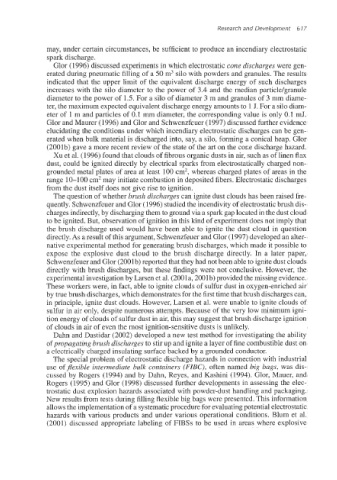Page 650 - Dust Explosions in the Process Industries
P. 650
Research and Development 6 17
may, under certain circumstances, be sufficient to produce an incendiary electrostatic
spark discharge.
Glor (1996) discussed experiments in which electrostatic cone discharges were gen-
erated during pneumatic filling of a 50 m3 silo with powders and granules. The results
indicated that the upper limit of the equivalent discharge energy of such discharges
increases with the silo diameter to the power of 3.4 and the median particle/granule
diameter to the power of 1.5. For a silo of diameter 3 m and granules of 3 mm diame-
ter, the maximum expected equivalent dischargeenergy amounts to 1J. For a silo diam-
eter of 1 rn and particles of 0.1 mm diameter, the corresponding value is only 0.1 mJ.
Glor and Maurer (1996) and Glor and Schwenzfeuer (1997) discussed further evidence
elucidating the conditions under which incendiary electrostatic discharges can be gen-
erated when bulk material is discharged into, say, a silo, forming a conical heap. Glor
(2001b) gave a more recent review of the state of the arton the cone discharge hazard.
Xu et al. (1996) found that clouds of fibrous organic dusts in air, such as of linen flax
dust, could be ignited directly by electrical sparks from electrostatically charged non-
grounded metal plates of area at least 100 cm2,whereas charged plates of areas in the
range 10-100 cm2may initiate combustion in deposited fibers. Electrostatic discharges
from the dust itself does not give rise to ignition.
The question of whether brush discharges can ignite dust clouds has been raised fre-
quently. Schwenzfeuerand Glor (1996) studiedthe incendivity of electrostatic brush dis-
charges indirectly,by dischargingthem to ground via a spark gap located in the dust cloud
to be ignited. But, observation of ignition in this kind of experiment does not imply that
the brush discharge used would have been able to ignite the dust cloud in
directly.As a result of this argument, Schwenzfeuerand Glor (1997) developed an alter-
native experimentalmethod for generating brush discharges, which made it possible to
expose the explosive dust cloud to the brush discharge directly. In a later paper,
Schwenzfeuer and Glor (2001b) reported that they had not been able to ignite dust clouds
directly with brush discharges, but these findings were not conclusive. However>the
experimentalinvestigationby Larsen et al. (2001a, 2001b)provided the missing evidence.
These workers were, in fact, able to ignite clouds of sulfur dust in oxygen-enriched air
by true brush discharges, which demonstratesfor the first time that brush discharges can,
in principle, ignite dust clouds. However, Larsen et al. were unable to ignite clouds of
sulfur in air only, despite numerous attempts. Because of the very low minimum igni-
tion energy of clouds of sulfur dust in air, this may suggest that brush dischargeignition
of clouds in air of even the most ignition-sensitivedusts is unlikely.
Dahn and Dastidar (2002) developed a new test method for investigating the ability
ofpropagating bruslz discharges to stir up and ignite a layer of fine combustibledust on
a electrically charged insulating surface backed by a grounded conductor.
The special problem of electrostatic discharge hazards in connection with industrial
use of jexible intermediate bulk containers (FIBC), often named big bags, was dis-
cussed by Rogers (1994) and by Dahn, Reyes, and Kashini (1994). Glor, Mauer, and
Rogers (1995) and Glor (1998) discussed further developments in assessing the elec-
trostatic dust explosion hazards associated with powder-dust handling and packaging.
New results from tests during filling flexible big bags were presented. This information
allows the implementation of a systematicprocedure for evaluatingpotential electrostatic
hazards with various products and under various operational conditions. Blum et al.
(2001) discussed appropriate labeling of FIBSs to be used in areas where explosive

